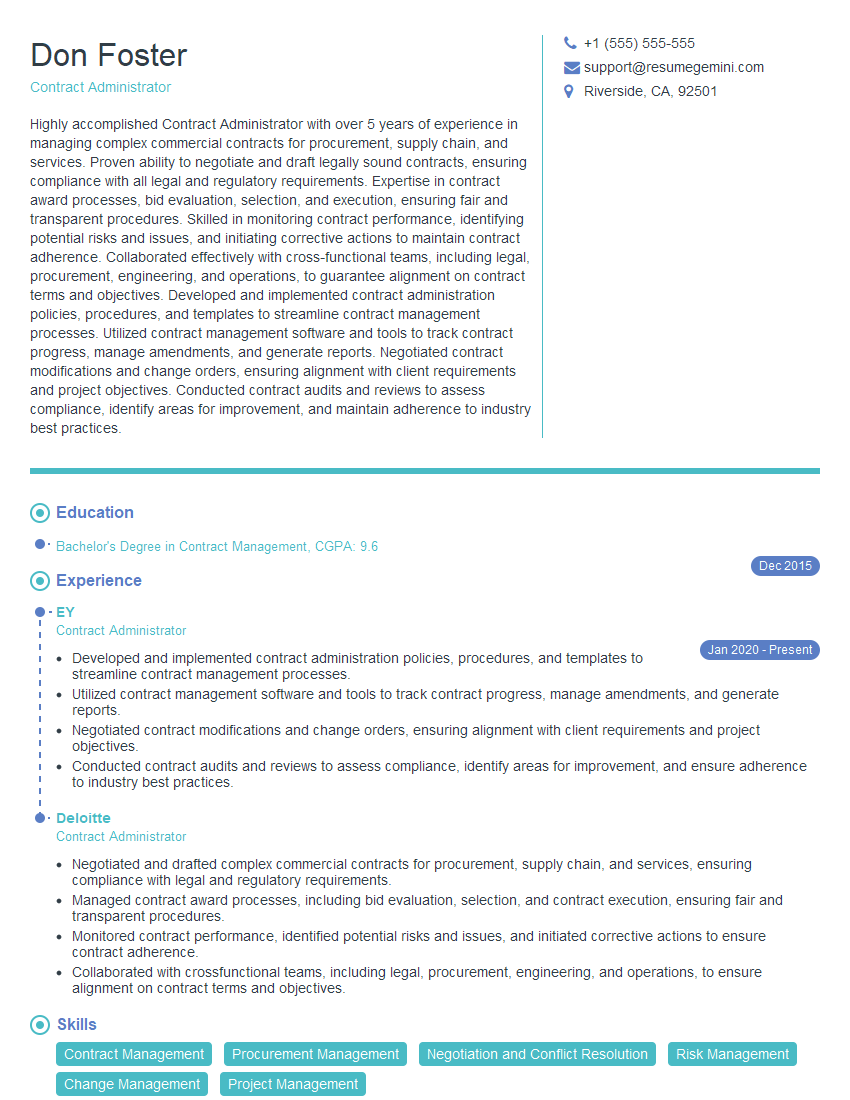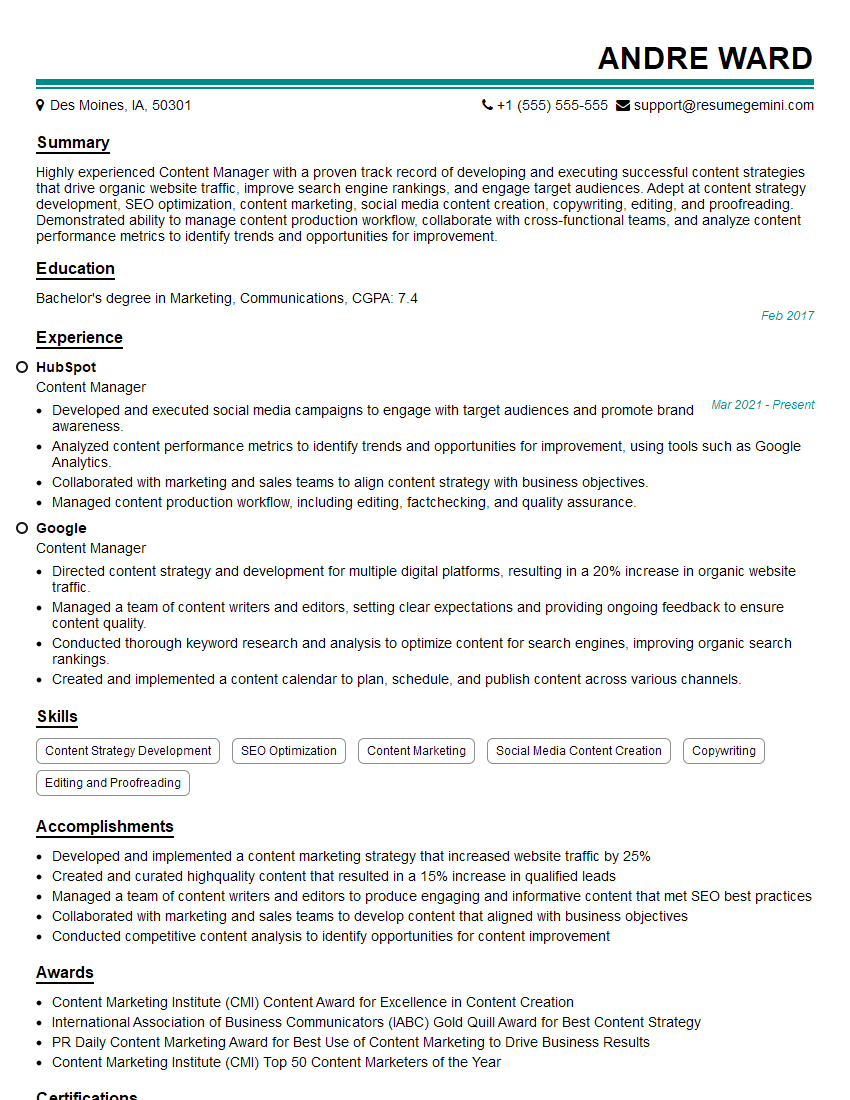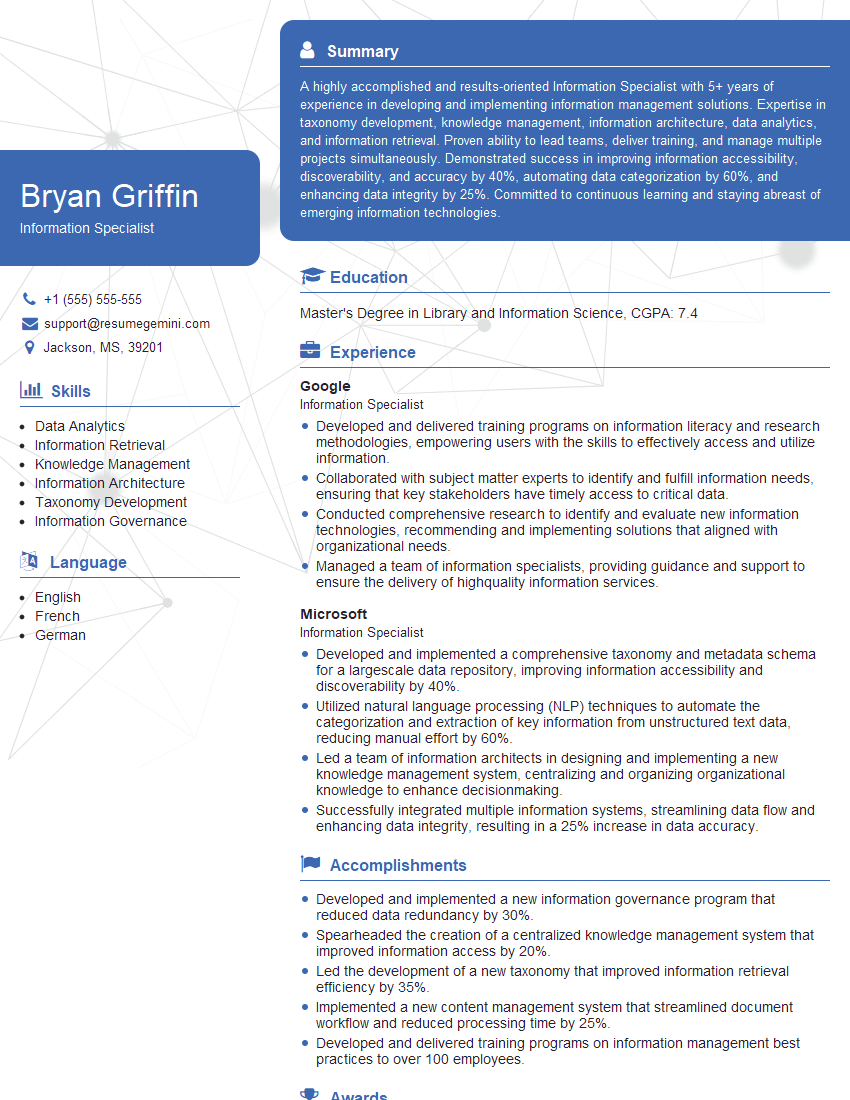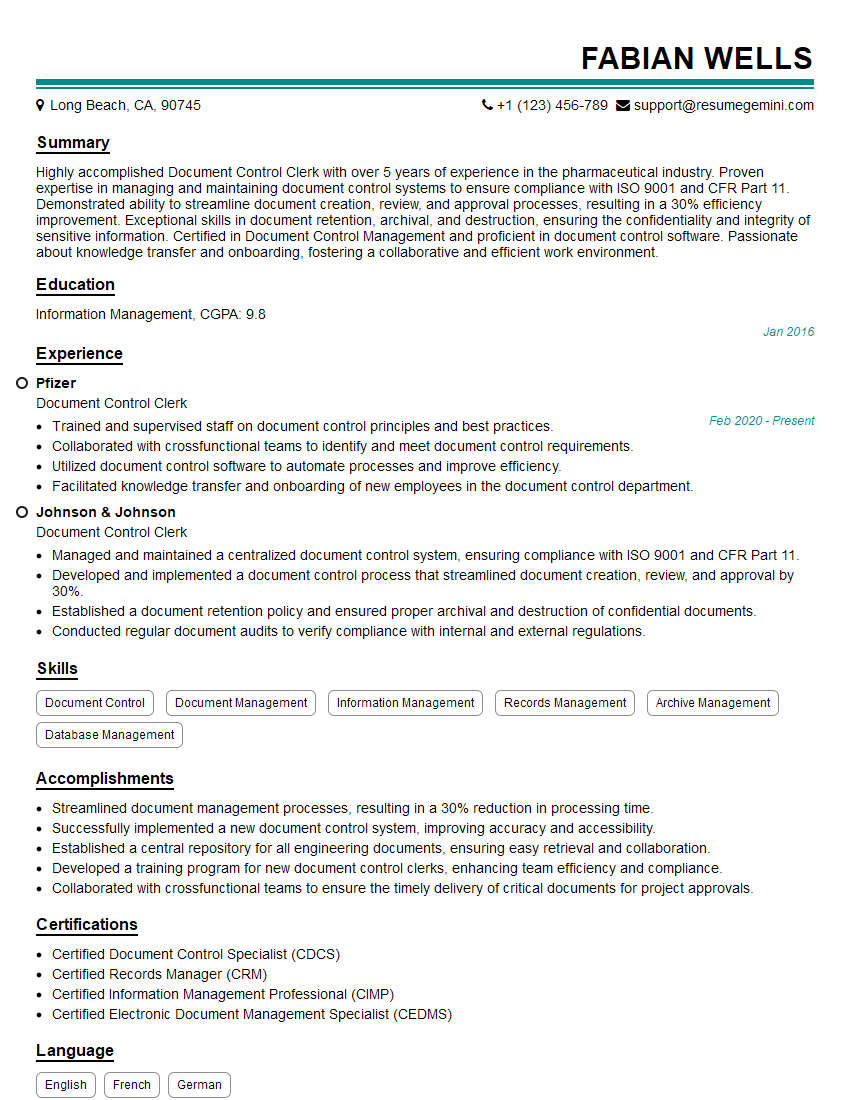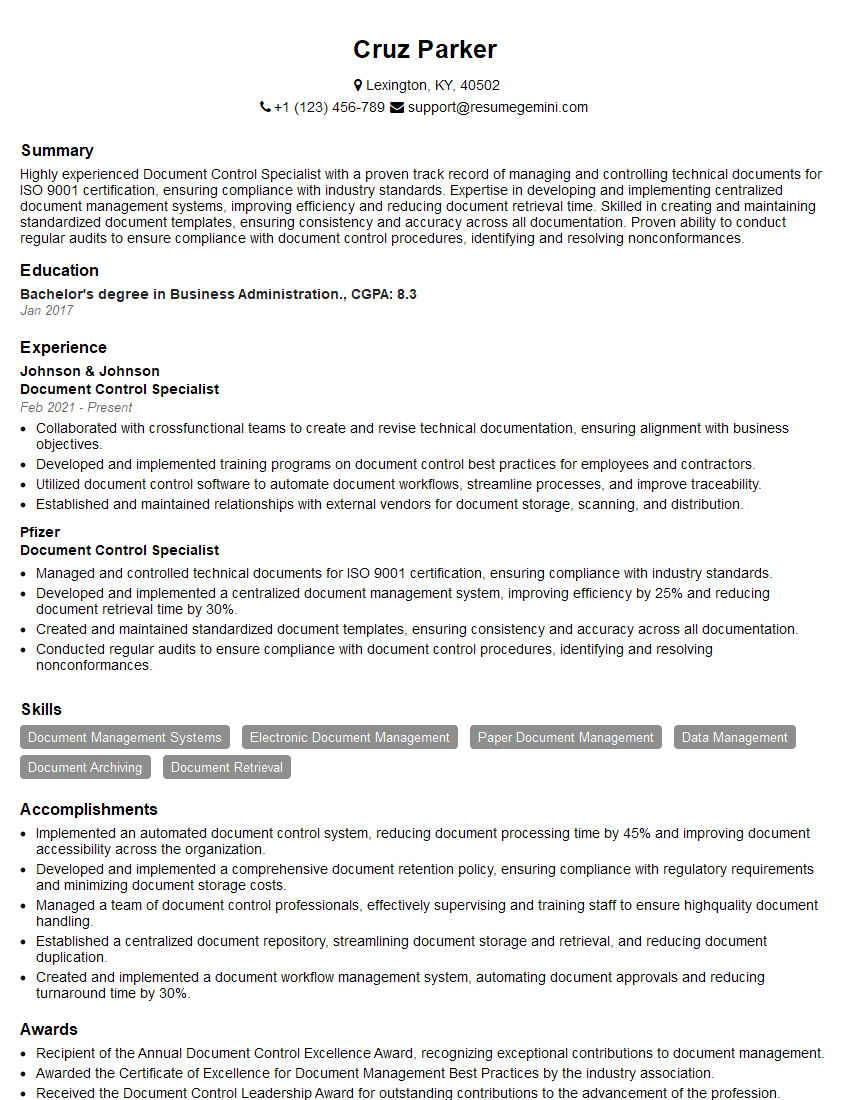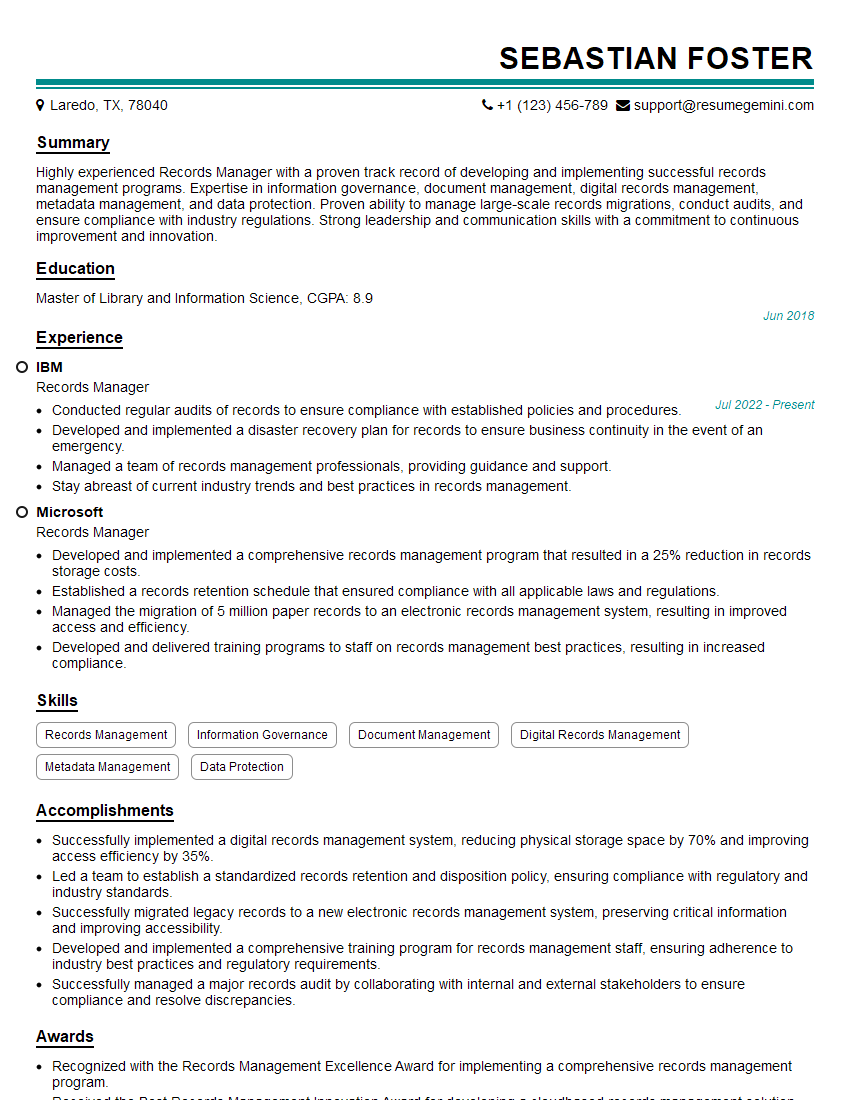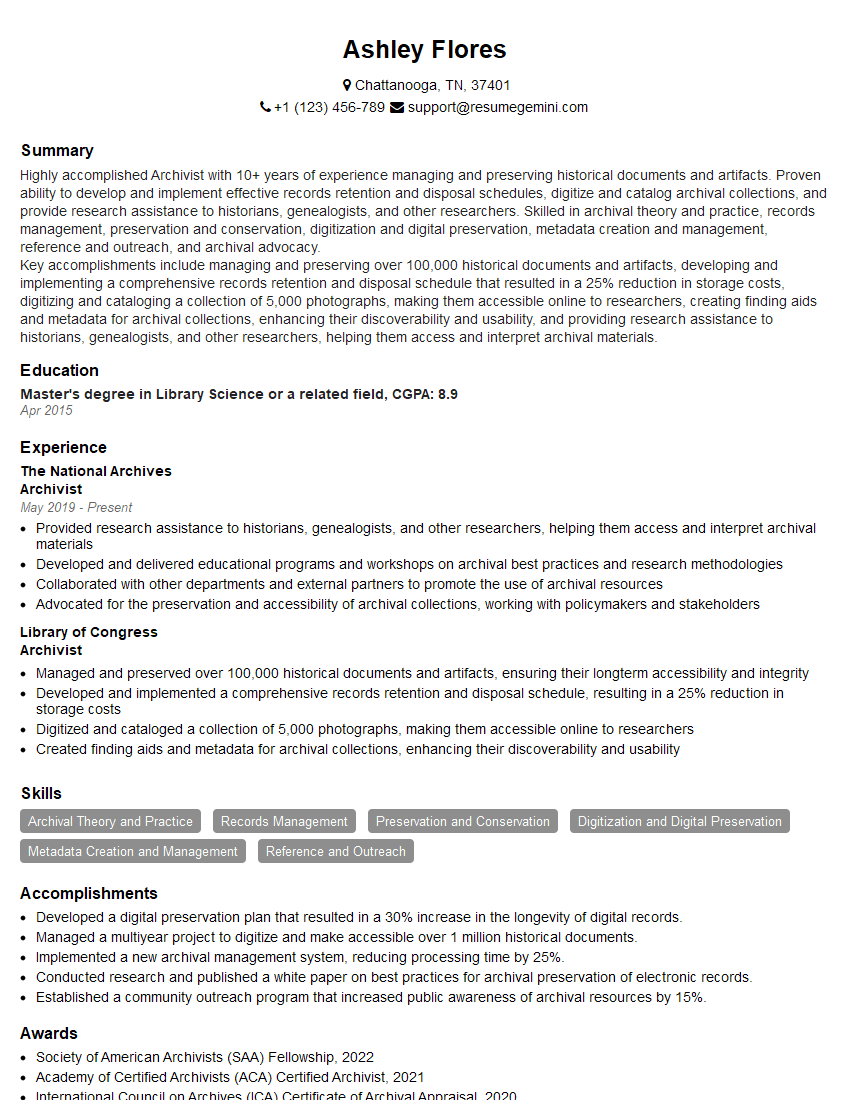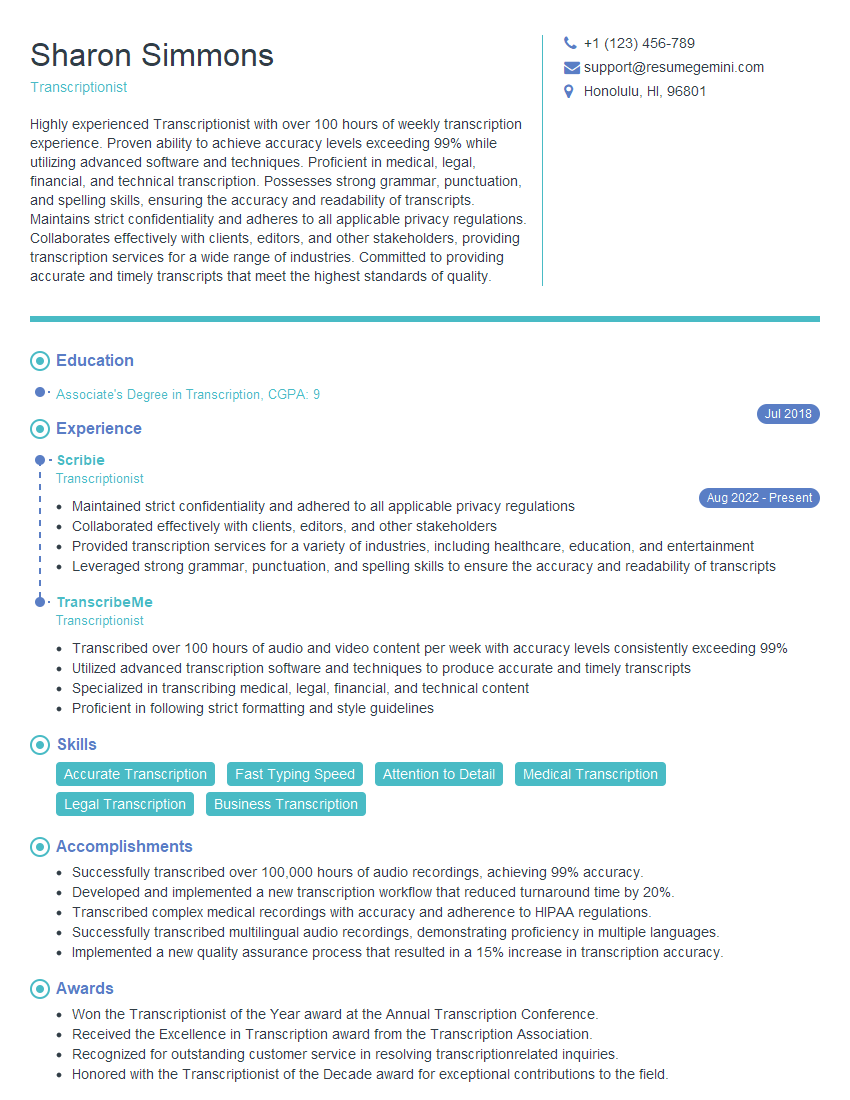Interviews are opportunities to demonstrate your expertise, and this guide is here to help you shine. Explore the essential Collating and Document Assembly interview questions that employers frequently ask, paired with strategies for crafting responses that set you apart from the competition.
Questions Asked in Collating and Document Assembly Interview
Q 1. Explain the difference between collating and assembling documents.
While both collating and assembling documents involve bringing together multiple pieces of information, they differ significantly. Collating focuses on arranging individual pages or documents into a predetermined order. Think of it like organizing a deck of cards – each card needs to be in its correct sequential position. Document assembly, on the other hand, is a more sophisticated process that involves merging data fields, such as names and addresses, into pre-designed templates to create personalized documents. It’s like creating customized invitations—you have a base template, and you insert different names and addresses for each recipient.
For example, collating might involve taking several printed reports and arranging them in numerical order. Document assembly, conversely, might involve generating hundreds of personalized contracts by pulling data from a database and inserting it into a standard contract template.
Q 2. Describe your experience with various document assembly software.
Throughout my career, I’ve gained extensive experience with various document assembly software, including industry-leading solutions like HotDocs, Adobe Acrobat Pro with its powerful form-filling capabilities, and custom-built solutions using scripting languages like Python and VBA. I’ve used HotDocs to streamline the creation of complex legal documents, leveraging its robust conditional logic to manage variable data inputs and generate tailored legal agreements. With Adobe Acrobat Pro, my proficiency extends to creating interactive forms, automating data extraction, and implementing robust validation rules to ensure data accuracy. My experience also includes developing custom document assembly solutions using Python and VBA, providing highly flexible and tailored workflows to specific client needs.
For instance, in one project, I used HotDocs to create a system that automatically generated personalized insurance policies, reducing processing time by 80% and minimizing manual errors. In another, I developed a VBA script that efficiently combined data from multiple Excel sheets into a single Word document report, improving efficiency and data consistency.
Q 3. How do you ensure accuracy when collating and assembling large volumes of documents?
Ensuring accuracy with large volumes is paramount. My approach involves a multi-layered strategy. Firstly, I meticulously check all data sources for consistency and completeness before the assembly process begins. This might involve data validation checks, using software features like data mapping in HotDocs or implementing custom validation routines in my scripts. Secondly, I implement robust quality control checks throughout the assembly process. This could include automated verification steps integrated into the software, as well as manual spot checks of the final output, using tools like checksums to verify file integrity. Finally, I utilize version control, keeping track of all changes and revisions, so I can easily revert to previous versions if needed.
Think of it like building a skyscraper – each element (data source, process step) needs to be rigorously inspected before moving to the next stage. This minimizes errors and ensures the final product (the assembled document) is structurally sound and accurate.
Q 4. What methods do you use to verify the completeness of assembled documents?
Verifying completeness involves a combination of automated and manual checks. Automated checks can include programmed logic within the assembly software, verifying that all required fields have been populated. Manual checks might involve a visual inspection of the final document to ensure all necessary sections, tables, and appendices are present and correctly ordered. Using checksums or other file integrity checks further validates that the assembled document is complete and hasn’t been corrupted during the process.
I often create checklists or templates specifying exactly what should be in each document. This acts as a cross-reference point during the verification phase, much like a pilot uses a pre-flight checklist to ensure their aircraft is ready for departure.
Q 5. How do you handle discrepancies or errors found during document assembly?
Discrepancies or errors are inevitable. My response follows a structured process. First, I identify the root cause – is it a data input error, a problem with the template, or a software glitch? Once identified, I correct the error, meticulously documenting the changes. Then, depending on the severity and the impact on downstream processes, I may re-process affected documents or implement preventative measures to stop the error from recurring. This might involve improving data validation, updating templates, or adding additional error-handling procedures within the assembly workflow.
The key here is to not just fix the immediate problem but to analyze and address the underlying cause to prevent future occurrences, just like a doctor would treat not just the symptoms of an illness, but the root cause as well.
Q 6. Describe your experience with different document formats (PDF, Word, etc.).
My experience encompasses a wide range of document formats, including PDF, Word (.docx), Excel (.xlsx), and plain text (.txt). I’m proficient in using various software tools to convert between these formats as needed, ensuring compatibility and seamless integration. I understand the strengths and limitations of each format and choose the appropriate one depending on the project requirements and audience. For instance, PDFs are excellent for archival and distribution, while Word documents offer greater flexibility for editing and modification. Excel spreadsheets are particularly useful for handling large datasets that feed into document assembly processes.
Choosing the right format is akin to selecting the best tool for a job – a hammer is ideal for driving nails, but not for screwing in screws.
Q 7. How do you prioritize tasks when dealing with multiple document assembly projects?
Prioritization depends on several factors: deadlines, client urgency, complexity of the projects, and resource availability. I typically use a combination of methods, including creating a prioritized task list based on deadlines and client needs. I also use project management software to track progress and allocate resources efficiently. I might employ agile methodologies, breaking down larger projects into smaller, manageable tasks, and continuously reassessing priorities based on progress and changing circumstances. Critical path analysis helps pinpoint the most time-sensitive tasks, ensuring that potential bottlenecks are addressed proactively.
This is much like a conductor leading an orchestra – each instrument (project) needs to play its part at the right time, ensuring a harmonious and timely performance.
Q 8. What strategies do you use to maintain document organization and accuracy?
Maintaining document organization and accuracy is paramount in collating and assembling documents. Think of it like building a house – you wouldn’t start laying bricks without a blueprint! My strategy involves a multi-pronged approach:
Clear Naming Conventions: I use consistent and descriptive file names, incorporating project codes, dates, and version numbers (e.g., ProjectAlpha_20241027_v1.docx). This allows for instant identification and prevents confusion.
Organized File Structure: I create a logical folder structure mirroring the project’s phases or sections. This could be a hierarchical structure with folders for each document type, drafts, final versions, and supporting materials. Think of it like a well-organized library – easy to find what you need.
Metadata Utilization: I leverage metadata within documents and file systems to capture key information like authors, creation dates, and keywords. This facilitates quick searching and retrieval.
Regular Backups: Data loss is a nightmare! I religiously back up all documents to multiple locations, using cloud storage and local drives, ensuring redundancy and data security.
Checklists and Templates: I create and utilize checklists to guide the collation process and ensure all necessary components are included. Templates for frequently used documents maintain consistency in formatting and content.
Q 9. Explain your experience with document version control.
Document version control is essential to avoid confusion and ensure everyone is working with the latest, accurate version. In my experience, I’ve utilized several methods:
Version Numbering: As mentioned earlier, consistent version numbering (v1, v2, etc.) clearly indicates revisions. I often include a brief description of changes made in the file name itself.
Cloud-Based Collaboration Tools: Tools like Google Drive or Microsoft SharePoint provide built-in version control. They track changes, allow for collaborative editing, and provide a history of revisions, allowing us to easily revert to previous versions if needed.
Dedicated Version Control Systems (e.g., Git): For larger, more complex projects, especially those involving multiple contributors, I’ve employed dedicated version control systems like Git. This offers granular control over changes and facilitates branching and merging, ideal for parallel development and feature management.
Centralized Document Repositories: Regardless of the tool used, I ensure all documents reside in a central repository, accessible to all authorized personnel. This minimizes the risk of working with outdated files.
Q 10. How do you handle confidential documents during the assembly process?
Confidentiality is paramount. Handling confidential documents requires rigorous measures:
Access Control: I restrict access to confidential documents using password protection, encryption, and access control lists (ACLs). Only authorized individuals have permissions to view or modify these files.
Secure Storage: Confidential documents are stored securely, using encrypted cloud storage or password-protected local drives. Physical documents are kept in locked cabinets or safes.
Data Deletion: Once a document is no longer needed, I securely delete it, ensuring that all copies are removed from all storage locations.
Non-Disclosure Agreements (NDAs): When working with highly sensitive information, I adhere to NDAs and ensure all parties involved understand and respect the confidentiality requirements.
Secure Printing and Handling: I use secure print release features to prevent unauthorized access to printed documents. Physical handling is minimized and controlled.
Q 11. Describe your experience with quality control checks in document assembly.
Quality control is an iterative process, not a single step. My approach includes:
Pre-Assembly Checks: Before assembly, I review individual documents for errors in formatting, content, and completeness. This preemptive step prevents compounding errors during assembly.
Post-Assembly Review: After assembly, a thorough review is crucial. This includes checking for page numbers, consistency in formatting (fonts, styles, headers, footers), and ensuring all required components are correctly placed and legible.
Automated Checks: Where possible, I utilize automated tools to identify spelling and grammar errors, and to check for formatting inconsistencies across the document.
Proofreading: A final, manual proofread is essential to catch any errors that automated checks might miss, particularly those related to context and meaning.
Client Review: A review by the client or relevant stakeholders is often part of the quality control process, ensuring that the final document meets their requirements and expectations.
Q 12. How familiar are you with different binding and finishing techniques?
My familiarity with binding and finishing techniques is comprehensive. I understand the various methods and their suitability for different types of documents. This includes:
Coil Binding: Suitable for documents needing frequent page turning, like notebooks or reports.
Saddle Stitch Binding: Cost-effective for thinner documents, ideal for brochures or booklets.
Perfect Binding: Common for books and magazines, providing a professional and durable finish.
Wire-O Binding: Provides a strong and lay-flat binding suitable for calendars or notebooks.
Case Binding: Used for larger, more complex documents requiring a robust and high-quality finish.
Beyond binding, I am experienced with finishing techniques like lamination, die-cutting, embossing, and folding, chosen based on the specific needs of the document and client preferences.
Q 13. What are your preferred methods for managing large document sets?
Managing large document sets efficiently requires a structured approach:
Database Management: For very large sets, a database system (like a relational database) can help organize, search and retrieve documents efficiently.
Document Management Systems (DMS): DMS software provides features for storing, retrieving, and managing large numbers of documents, including version control and metadata management.
Cloud Storage: Cloud storage platforms offer scalable storage options, allowing for the management of extremely large document sets, with built-in collaboration and access control features.
Metadata Tagging: Consistent and thorough metadata tagging is essential for effective searching and retrieval within large document sets.
Regular Archiving: Periodic archiving of inactive documents keeps the active set manageable, while ensuring easy access to older materials when needed.
Q 14. How do you ensure compliance with document formatting standards?
Ensuring compliance with document formatting standards is crucial for professionalism and consistency. My approach is multifaceted:
Style Guides: I meticulously follow relevant style guides (e.g., Chicago Manual of Style, APA, MLA) to ensure consistency in formatting, citation, and writing style.
Templates: Using pre-designed templates for documents helps enforce formatting standards automatically.
Automated Formatting Tools: Tools like Microsoft Word’s styles and formatting features help maintain consistency, simplifying the process.
Review and Quality Control: Regular review throughout the assembly process ensures that the document consistently conforms to established standards.
Client Specifications: I carefully review client-provided style guides or specifications to meet specific requirements.
Q 15. What is your experience with automated document assembly tools?
My experience with automated document assembly tools spans over eight years, encompassing a variety of platforms including HotDocs, MS Word mail merge, and specialized legal document automation software. I’ve used these tools to create countless documents ranging from simple letters and contracts to complex legal agreements and financial reports. For example, in my previous role, I automated the creation of personalized client onboarding packages using HotDocs, significantly reducing processing time and improving accuracy. This involved mapping data fields from a CRM system to customizable templates, ensuring consistent branding and accurate information across all documents. I’m proficient in using both rule-based and data-driven assembly methods, understanding the strengths and weaknesses of each approach for different document types.
I’m also adept at integrating these tools with other software, such as CRM systems and databases, to streamline the entire document lifecycle. This integration minimizes manual data entry, reduces human error, and increases efficiency.
Career Expert Tips:
- Ace those interviews! Prepare effectively by reviewing the Top 50 Most Common Interview Questions on ResumeGemini.
- Navigate your job search with confidence! Explore a wide range of Career Tips on ResumeGemini. Learn about common challenges and recommendations to overcome them.
- Craft the perfect resume! Master the Art of Resume Writing with ResumeGemini’s guide. Showcase your unique qualifications and achievements effectively.
- Don’t miss out on holiday savings! Build your dream resume with ResumeGemini’s ATS optimized templates.
Q 16. Explain your process for troubleshooting issues during document assembly.
Troubleshooting document assembly issues is a systematic process for me. I begin by identifying the specific error or unexpected output. This might involve checking the assembled document for inconsistencies, reviewing error logs provided by the assembly software, or examining the data source for inaccuracies. My approach is similar to a detective investigation.
- Step 1: Isolate the Problem: I carefully examine the error message or the specific point of failure in the assembled document. This helps pinpoint the source of the problem (e.g., data field mismatch, incorrect template logic, or a flaw in the data source).
- Step 2: Check the Data Source: I verify the accuracy and completeness of the data being used in the assembly. Inconsistent or missing data is a common culprit. I often use data validation tools to ensure data integrity.
- Step 3: Review the Template Logic: I meticulously review the document template’s logic to identify any coding errors, conditional statements that aren’t functioning correctly, or incorrect field mappings. This often involves stepping through the assembly process line-by-line.
- Step 4: Test and Iterate: Once I’ve identified and corrected the issue, I conduct thorough testing with various data sets to ensure the problem is resolved and the assembly process is working correctly. I meticulously document every step of this troubleshooting process for future reference.
For example, I once encountered an issue where a conditional statement in a HotDocs template wasn’t working as expected. By systematically stepping through the logic, I identified a syntax error that was preventing the correct clause from being inserted into the document. Correcting this simple error resolved the problem.
Q 17. How do you stay organized when working on multiple projects with overlapping deadlines?
Managing multiple projects with overlapping deadlines requires meticulous organization. My approach involves a combination of project management tools and personal strategies. I rely heavily on project management software like Asana or Trello to create detailed task lists, set deadlines, and track progress. Each project is broken down into smaller, manageable tasks, assigned priorities, and scheduled accordingly.
I also employ time-blocking techniques, allocating specific time slots for each project. This structured approach helps me maintain focus and prevents tasks from spilling over into one another. Regular reviews and prioritization adjustments are vital to ensure I stay on track, particularly when faced with unexpected changes or urgent requests.
For example, I might use color-coding in my project management software to represent the urgency or priority level of each task, allowing me to immediately see which tasks demand immediate attention. This visual representation simplifies prioritization and ensures that the most critical aspects of each project receive the necessary focus.
Q 18. Describe your experience with using metadata to organize documents.
Metadata is crucial for efficient document organization and retrieval. I use metadata to tag documents with relevant keywords, subject matter, client information, and date ranges. This enables me to easily locate specific documents using search functions or filtering criteria. I leverage the metadata capabilities of various document management systems (DMS) and file storage platforms, including SharePoint and cloud-based solutions.
For example, when processing legal documents, I would tag each document with metadata including case number, client name, date of creation, and relevant legal topics. This makes it simple to quickly find any particular document within a large repository. Consistent and accurate metadata application is paramount for effective searching and retrieval.
Q 19. How do you handle requests for expedited document assembly?
Handling expedited document assembly requests requires a flexible and adaptable approach. I prioritize such requests by assessing their urgency and impact. Open communication with the requester is key to understanding their timeline and any potential compromises that might be necessary.
My strategy typically involves: (1) Assessing the complexity of the request; (2) Identifying any potential bottlenecks in the process; (3) Reallocating resources if necessary; and (4) Communicating realistic timelines to the requester. Sometimes, this means working outside of regular hours or collaborating with colleagues to ensure timely completion. Transparent communication is crucial to manage expectations.
For example, if I receive an urgent request for a contract, I would quickly evaluate the data availability and template readiness. If the data is readily available and the template is well-structured, I can often expedite the process with minimal compromise. However, if the data is incomplete or the template requires significant modification, I’ll discuss potential adjustments to the timeline with the requester.
Q 20. What is your experience with document indexing and retrieval systems?
I have extensive experience with various document indexing and retrieval systems. My experience includes working with both commercial DMS (like SharePoint and M-Files) and open-source solutions. I understand the importance of selecting the right system based on the specific needs of the organization. This includes considering factors such as scalability, security, integration with other systems, and the level of user training required.
My skills extend to developing and implementing indexing strategies, ensuring accurate and consistent indexing for efficient searching and retrieval. I’m familiar with different indexing methods, including keyword indexing, metadata-based indexing, and full-text indexing, choosing the most appropriate method based on the document type and search requirements.
For example, in a previous project, I helped a law firm transition from a paper-based filing system to a fully digital document management system. This involved designing a comprehensive metadata schema, developing custom indexing rules, and training staff on the new system. The result was a significant improvement in document retrieval efficiency and reduction in storage costs.
Q 21. How familiar are you with different filing systems (electronic and physical)?
I’m familiar with a wide range of filing systems, both electronic and physical. My experience with physical filing systems includes working with both alphabetic and numeric filing systems, understanding the importance of consistent and logical filing structures for efficient retrieval. I know how to create and maintain comprehensive filing systems that comply with regulatory requirements and support efficient workflow.
My experience with electronic filing systems is even more extensive, encompassing various DMS (document management systems), cloud-based storage solutions (like Dropbox, Google Drive, OneDrive), and enterprise-level systems (like SharePoint). I’m skilled in organizing electronic files using folders, tags, and metadata to ensure efficient searching and retrieval. I also understand the importance of data security and backup strategies for electronic files.
For instance, I’ve helped organizations transition from outdated paper-based filing systems to efficient electronic systems, saving space, time and improving compliance.
Q 22. Describe your experience with document scanning and digitization.
My experience with document scanning and digitization spans several years and various technologies. I’m proficient in using both high-volume scanners for large-scale projects and smaller, portable scanners for individual documents. I understand the importance of different scanning resolutions (DPI) to balance image quality with file size, and I’m familiar with various file formats like TIFF, JPEG, and PDF, selecting the appropriate format based on the document’s purpose and storage requirements.
For instance, when digitizing historical legal documents, a high DPI TIFF is preferred to maintain archival quality. However, for everyday office documents, a compressed JPEG or PDF might suffice. I’m also experienced in using Optical Character Recognition (OCR) software to convert scanned images into editable text, a crucial step for searchable and reusable documents. This involves carefully selecting the correct language settings and optimizing the OCR process to achieve high accuracy, addressing any errors manually when necessary. My experience extends to managing the metadata associated with digitized documents, ensuring proper indexing and retrieval capabilities for efficient future use.
Q 23. How do you ensure the security of sensitive documents during the assembly process?
Security is paramount when handling sensitive documents. My approach involves a multi-layered strategy. First, physical security measures are essential: secure storage for physical documents before and after scanning, access control to scanning equipment, and secured storage for digital files. Secondly, I employ robust access control measures for digital documents, utilizing encryption, password protection, and access permissions based on the ‘need-to-know’ principle within our document management system (DMS). We regularly review and update these permissions to reflect changes in personnel and project requirements.
Thirdly, I meticulously follow data destruction protocols for obsolete documents, both physical and digital, ensuring compliance with regulations like GDPR. Finally, regular security audits and training are critical to maintaining a secure environment. We use intrusion detection systems and regularly back up our data to geographically separate locations to minimize the risk of data loss or unauthorized access. Think of it like a fortress with multiple layers of defense, each protecting the sensitive information within.
Q 24. What measures do you take to prevent document loss or damage?
Preventing document loss or damage involves a combination of proactive measures and robust recovery strategies. For physical documents, this includes proper storage in climate-controlled environments, using archival-quality folders and boxes, and handling documents with care to avoid tearing or creasing. Regular inspections help identify any deterioration early on. For digital documents, version control is crucial. We maintain multiple backups, using a 3-2-1 backup strategy (3 copies on 2 different media, with 1 copy offsite), and regularly test the recovery process.
Furthermore, our DMS employs robust redundancy measures, and we utilize checksums to verify data integrity after every backup. We also implement a detailed document tracking system, allowing us to easily locate and manage every document throughout its lifecycle. For example, if a crucial document is accidentally deleted, we can easily recover it from our backups. This proactive approach minimizes the risk of irretrievable loss and ensures business continuity.
Q 25. Describe your experience working with document management systems (DMS).
I have extensive experience with various document management systems (DMS), including both cloud-based and on-premise solutions. My expertise extends beyond simply using the software to include configuring and customizing DMS to optimize workflow and meet specific business needs. I’m comfortable working with metadata schemas, user roles and permissions, workflows, and document version control. For example, I’ve successfully implemented a DMS solution for a law firm, streamlining their document management and improving efficiency by 30% through better organization and automated workflows. This involved tailoring the system to handle sensitive client data while ensuring compliance with industry regulations.
In another project, I helped a marketing team migrate their document storage from a shared network drive to a cloud-based DMS, improving accessibility and collaboration among team members across different locations. I understand the nuances of different DMS platforms and can quickly adapt to new systems as needed, focusing on leveraging their features to maximize efficiency and security.
Q 26. How do you adapt to changes in document assembly processes or software?
Adaptability is crucial in this field. I approach changes in document assembly processes or software by first understanding the reason behind the change and its impact on existing workflows. This often involves collaborating with stakeholders to assess the new process or software thoroughly. I then focus on identifying any potential challenges and developing a plan to mitigate those risks. This might involve training sessions for colleagues, creating detailed documentation, or even developing small scripts or macros to automate repetitive tasks.
For example, when our company switched to a new DMS, I proactively sought training and then helped my colleagues transition smoothly by creating a comprehensive training guide and a series of short video tutorials. I embrace continuous learning and readily engage with online resources, webinars, and professional development opportunities to keep my skills up-to-date with the latest technologies and best practices.
Q 27. What are your strengths and weaknesses when it comes to document assembly?
My strengths lie in my meticulous attention to detail, my ability to understand complex document structures, and my proficiency in various document assembly software and techniques. I’m also a highly organized and efficient worker, capable of managing large volumes of documents while maintaining accuracy and consistency. I excel at problem-solving and troubleshooting unexpected issues that arise during the assembly process.
One area where I can improve is enhancing my proficiency in advanced scripting languages for more complex automation tasks. While I can manage most automation needs with existing tools, learning more advanced scripting will allow me to create more robust and efficient solutions for larger-scale projects. I’m actively working on improving this skill through online courses and self-directed learning.
Q 28. Describe a time you had to overcome a challenge during document assembly.
During a large-scale document assembly project for a major financial institution, we encountered a significant challenge: the source data contained inconsistencies and errors that were causing the automated assembly process to fail. This resulted in delays and threatened the project deadline. My approach involved a systematic problem-solving strategy.
First, I meticulously analyzed the data to identify the root causes of the errors. Then, I developed a data cleaning and validation process using scripting and spreadsheet tools. Finally, I implemented checks and balances in the assembly process to prevent such errors from recurring. This involved close collaboration with the data provider to address the issues at their source. Through diligent work and a collaborative effort, we successfully resolved the issues and completed the project on time, demonstrating my ability to overcome significant challenges under pressure and my commitment to delivering high-quality results.
Key Topics to Learn for Collating and Document Assembly Interview
- Understanding Document Types and Formats: Become familiar with various document formats (PDF, Word, Excel, etc.) and their implications for collation and assembly. Consider the challenges of handling different versions and revisions.
- Collation Techniques and Methodologies: Explore different methods of collating documents, including manual, semi-automated, and fully automated processes. Understand the advantages and disadvantages of each approach in different contexts.
- Data Integrity and Accuracy: Master techniques to ensure data accuracy throughout the collation and assembly process. Discuss methods for verifying data consistency and identifying potential errors.
- Software Proficiency: Showcase your skills in relevant software like Adobe Acrobat, Microsoft Office Suite, or specialized document management systems. Be prepared to discuss your experience with specific features and functionalities.
- Workflow Optimization: Learn how to streamline the document assembly process for efficiency and accuracy. Discuss techniques for improving workflow, reducing errors, and meeting deadlines.
- Quality Control and Assurance: Understand the importance of quality control in document assembly. Be prepared to discuss your approach to identifying and correcting errors, and ensuring final product accuracy.
- Problem-Solving and Troubleshooting: Practice identifying and resolving common issues that may arise during collation and assembly, such as missing pages, incorrect formatting, or data inconsistencies.
- Security and Confidentiality: Understand the importance of maintaining data security and confidentiality when handling sensitive documents. Discuss best practices for secure document handling and storage.
Next Steps
Mastering Collating and Document Assembly is crucial for career advancement in many administrative and organizational roles. Proficiency in these skills demonstrates attention to detail, accuracy, and efficiency – highly valued attributes in today’s workplace. To significantly boost your job prospects, create an ATS-friendly resume that highlights your skills and experience effectively. ResumeGemini is a trusted resource to help you build a professional resume that stands out. We provide examples of resumes tailored to Collating and Document Assembly to guide you in creating your own compelling application.
Explore more articles
Users Rating of Our Blogs
Share Your Experience
We value your feedback! Please rate our content and share your thoughts (optional).
What Readers Say About Our Blog
Hello,
We found issues with your domain’s email setup that may be sending your messages to spam or blocking them completely. InboxShield Mini shows you how to fix it in minutes — no tech skills required.
Scan your domain now for details: https://inboxshield-mini.com/
— Adam @ InboxShield Mini
Reply STOP to unsubscribe
Hi, are you owner of interviewgemini.com? What if I told you I could help you find extra time in your schedule, reconnect with leads you didn’t even realize you missed, and bring in more “I want to work with you” conversations, without increasing your ad spend or hiring a full-time employee?
All with a flexible, budget-friendly service that could easily pay for itself. Sounds good?
Would it be nice to jump on a quick 10-minute call so I can show you exactly how we make this work?
Best,
Hapei
Marketing Director
Hey, I know you’re the owner of interviewgemini.com. I’ll be quick.
Fundraising for your business is tough and time-consuming. We make it easier by guaranteeing two private investor meetings each month, for six months. No demos, no pitch events – just direct introductions to active investors matched to your startup.
If youR17;re raising, this could help you build real momentum. Want me to send more info?
Hi, I represent an SEO company that specialises in getting you AI citations and higher rankings on Google. I’d like to offer you a 100% free SEO audit for your website. Would you be interested?
Hi, I represent an SEO company that specialises in getting you AI citations and higher rankings on Google. I’d like to offer you a 100% free SEO audit for your website. Would you be interested?
good
